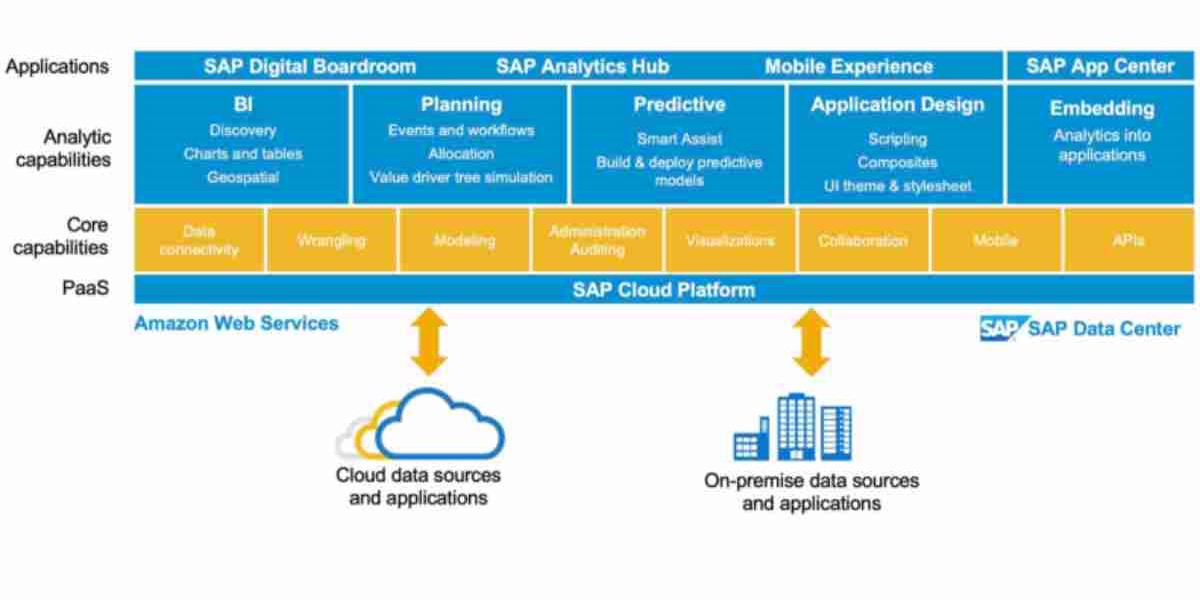In today’s data-driven world, businesses are increasingly relying on advanced analytics to turn their data into actionable insights. SAP Analytics Cloud (SAC) stands out as a top choice for this purpose, offering a comprehensive, cloud-based platform that combines business intelligence, predictive analytics, and planning capabilities all in one place. This powerful tool helps organizations understand their data, make informed decisions, and plan effectively for the future.
Hosted on the SAP Business Technology Platform (BTP), SAP Analytics Cloud integrates various analytics functions into a single, unified platform. It connects to a wide range of data sources, both cloud-based and on-premises, giving users a comprehensive view of their organizational data. SAC supports connections to SAP systems like SAP BW, SAP HANA, and SAP S/4HANA, as well as non-SAP applications such as Google BigQuery and SQL databases. It also provides access to over 100 pre-built SAP business content packages, which help speed up project setup and enhance analytics capabilities.
One of SAC's key features is its ability to connect to different data sources through live connections and data acquisition methods. Live connections allow for real-time data retrieval from systems like SAP BW and SAP HANA, ensuring users always have the most current information. Data acquisition involves copying data into SAC for analysis, which is useful when real-time connectivity isn’t available. SAP Data Warehouse Cloud further enhances these capabilities by allowing real-time analysis of data from various sources, even if direct connections aren't possible.
SAC’s architecture supports business intelligence, enterprise planning, and predictive analytics through a three-layer structure. The core layer includes the SAP HANA database and the SAC application server, which handle data processing and application functionality. The data layer connects SAC to various data sources, whether they are on-premises or in the cloud. The user layer includes the web application, mobile app, and SDK, allowing users to access SAC from any device with a browser.
Another strong feature of SAC is its data integration capabilities. The platform helps users consolidate data from different sources, whether it’s from SAP systems, spreadsheets, or cloud applications. With the SAP Analytics Cloud Modeler, users can prepare and transform data for analysis and planning. SAC also integrates with Microsoft Office, allowing seamless interaction with Excel. Beyond traditional business intelligence, SAC incorporates advanced analytics, including predictive analytics and machine learning. This means users can uncover hidden patterns, forecast trends, and make data-driven predictions for deeper insights.
SAC simplifies planning and budgeting by streamlining financial planning processes and enabling collaborative budget creation. The platform supports various planning activities, including what-if scenarios and variance analysis, making it easier for users to make informed decisions. Real-time collaboration features, such as comments and data actions, help align strategies and objectives.
Collaboration is another key aspect of SAC. It provides tools for sharing visualizations, reports, and dashboards with colleagues and stakeholders. Users can discuss data, post comments, and assign tasks within the platform, creating a collaborative environment for data-driven decision-making.
The benefits of SAC are significant. As a cloud-based solution, it offers accessibility from anywhere and scales to meet organizational needs, eliminating the need for infrastructure maintenance. It supports self-service analytics, allowing users to create dashboards and reports without needing programming skills, which enhances agility and responsiveness. Integration with other SAP products ensures real-time data communication and leverages existing technology investments. SAC also emphasizes security and data governance with features like role-based access control, encryption, and compliance with industry standards such as GDPR.
Recent updates to SAC, such as the unification of stories and analytic applications, improved support for running total calculations, and enhanced planning features, show SAP’s commitment to continuously improving the platform. Upcoming features include integrations with SAP Data Sphere, support for custom data sources, and enhancements to custom widgets, reflecting SAC’s ongoing evolution to meet user needs and market demands.
In summary, SAP Analytics Cloud is a versatile and robust platform that integrates business intelligence, planning, and advanced analytics into a single solution. By utilizing its comprehensive features, organizations can gain valuable insights, streamline planning processes, and make informed decisions, giving them a competitive edge in today’s data-driven world.






Comments